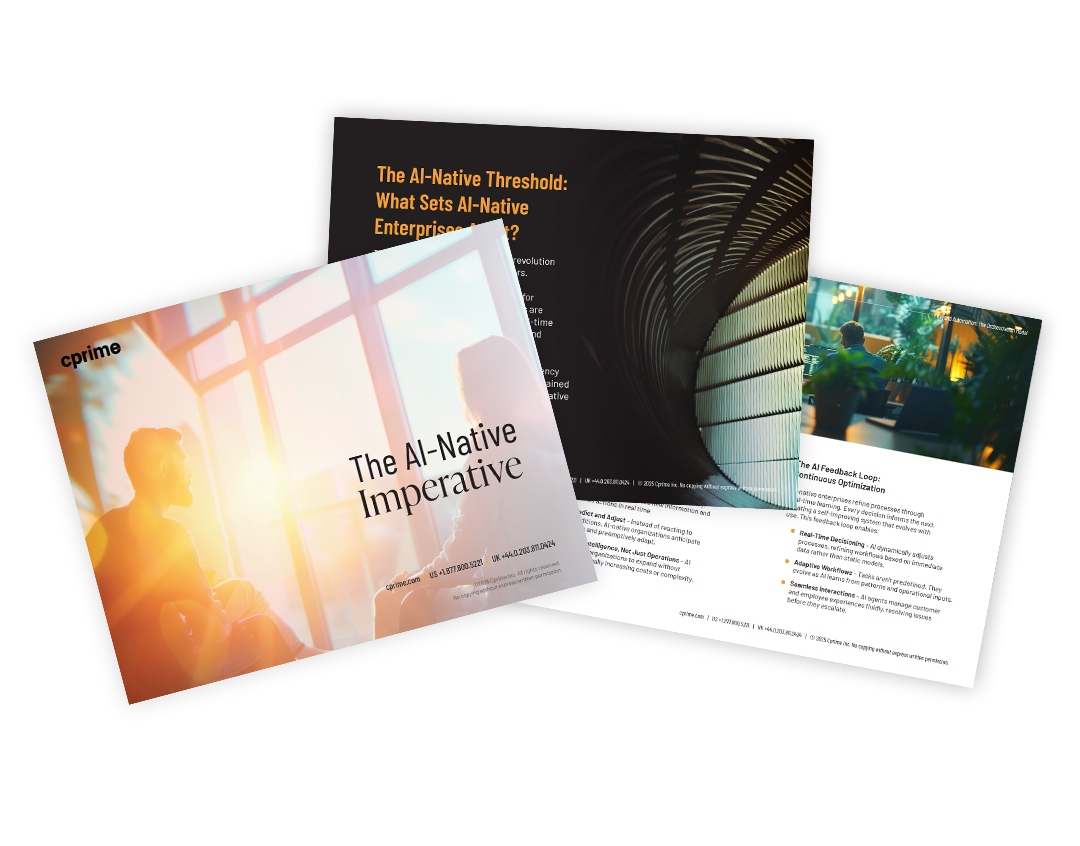Change Management in AI Adoption: Effective Strategies for Managing Organizational Change While Implementing AI
Artificial intelligence (AI) is a living, learning capability that only achieves full impact when paired with human-centered change management. Think of AI and change management as a symbiotic pair: AI supplies the insight and automation that can reinvent how work gets done, while change management provides the human alignment, culture-building, and governance that let those insights take root and scale. Each amplifies the other.
Introducing AI reshapes how people make decisions, collaborate, and create value.
This blog explores how embedding proven change management practices into every stage of AI adoption—discovery, implementation, optimization, and value realization—turns isolated pilots into enduring, enterprise-wide advantage.
Successfully integrating AI into an organization requires personal investment from all affected parties, from leadership to frontline employees. Failure to secure this buy-in leads to wasted resources and resistance, as individuals grapple with fears of job displacement, loss of control, and uncertainty about AI’s purpose and impact.
To navigate this, organizations must adopt a strategic, human-centric approach, leveraging established change management practices. Success depends on:
- Transparent, ongoing communication that addresses specific stakeholder concerns
- Executive leadership that champions AI and cultivates adaptability
- Early-stage engagement that co-designs the AI journey and validates value through pilot programs
Empowering people at every level is central to AI success. Organizations unlock strategic advantage by building a culture that values human-AI collaboration. Focusing exclusively on the mechanics of AI often sidelines its most important dimension: empowering your people.
1. Discovery & Strategy: Laying a Strong Strategic Foundation
Every successful AI adoption starts with a strong strategic foundation. First, surface the highest-impact opportunities across the business, from automating back-office workflows to embedding intelligence into customer-facing products. Use a proven readiness model to benchmark data, talent, and infrastructure against industry standards, revealing both strengths to leverage and gaps to close.
Translate those insights into a pragmatic roadmap that balances quick-win pilots with bold, long-horizon initiatives, each backed by a clear business case and defensible ROI model.
Throughout, bring the right voices to the table—executives, domain experts, compliance, and frontline teams—to secure sponsorship and reduce risk. Pair the technical plan with a targeted change management playbook: structured communications, hands-on enablement, and a culture-building program that turns wary employees into empowered AI champions.
The result is an AI strategy that is not just technically sound but financially disciplined and fully integrated into your organization’s DNA.
2. Implement & Integrate: Turning Vision into Action
With a strategy in place, delivery begins, translating ambition into capability that augments human decision-making and accelerates team performance. We weave AI into the tools teams already trust, whether Atlassian, ServiceNow, or bespoke platforms, so intelligence feels like a natural enhancement, not a disruptive shift.
Start with targeted pilots where the upside is clear and human expertise is indispensable, proving that algorithms combined with people outperform either alone. From day one, instrument workflows with performance and safety dashboards to detect and resolve drift, bias, or bottlenecks before they escalate.
In parallel, roll out role-specific enablement—from bite-size tutorials for frontline staff to deep-dive labs for data scientists—helping every employee master new capabilities and reinvest saved time into higher-value, creative work. By the end of this phase, AI is a trusted co-pilot that amplifies human judgment and frees talent to focus on what only people can do.
3. Tune & Optimize: Refining Performance and Experience
Post-implementation, sustained value depends on rigorous tuning. Establish a governance layer that blends security controls with clear accountability for model performance, ethics, and data privacy. A Center of Excellence—staffed by AI specialists and front-line power users—creates a real-time feedback loop for continuous improvement.
Ongoing scenario-based testing keeps bias, drift, and edge cases in check, ensuring AI systems remain trustworthy across conditions. Just as important, continue human enablement through onboarding sessions, refresher courses, and role-specific playbooks.
Targeted communications celebrate quick wins and share lessons learned, building confidence and curiosity across the organization.
4. Value Realization: Scaling Impact
When AI becomes an enterprise-wide capability, success is measured by how far and how sustainably it multiplies human potential. Wire each use case into a live scorecard of KPIs and value metrics, paired with ongoing pulse checks on adoption, readiness, and employee sentiment.
Advanced analytics surface underutilized areas or friction points, allowing teams to adjust both technology and supporting processes. Early wins are shared, scaled, and celebrated to accelerate momentum. Internal Centers of Excellence turn grassroots expertise into repeatable playbooks and reusable assets.
To ensure inclusive and ethical growth, maintain open forums and clear accountability across operations. This creates a scalable AI ecosystem that compounds value and supports the people driving your enterprise forward.
5. Future-Proofing: Sustaining Long-Term Advantage
AI is always evolving, and future-ready organizations evolve with it. Build for adaptability by championing continuous learning and expanding the AI frontier, from dashboards to prediction, prescription, and eventually autonomous support.
At every stage, AI should amplify human ingenuity. Algorithms handle the analysis so people can focus on strategy, creativity, and relationships. Promote this mindset through cultural touchpoints like guilds, lunch-and-learns, and communities of practice. Grow in-house talent that can lead future waves of innovation.
When technical roadmaps are interwoven with cultural evolution, AI becomes part of your organizational DNA: resilient, adaptable, and ready for what’s next.
Change Management Strategies for AI Success
- Living Documentation: Keep artifacts current to reflect real-time changes in implementation.
- Tailored Solutions: Adapt change approaches to your business context and tools.
- Expert Guidance: Leverage experienced change professionals familiar with AI projects.
- Proven Practices: Ground your approach in established principles from Lean Change Management or CMI.
- People First: Involve employees early through workshops, feedback loops, and consistent communication.
- Visual Clarity: Use change kanbans and impact maps to show how AI impacts different functions.
Earning Advocacy and Engagement
- Communicate Clearly: Articulate the benefits of AI in plain language and address concerns transparently.
- Empower Champions: Support influential employees who can advocate for AI change.
- Invest in Training: Provide role-specific learning to build confidence and fluency.
- Celebrate Wins: Highlight and amplify early successes to build enthusiasm and momentum.
The Bottom Line
Integrating AI into your organization requires more than just technical implementation. With a clear change strategy and a focus on people, you can orchestrate adoption, accelerate impact, and unlock the full potential of AI across your enterprise.


